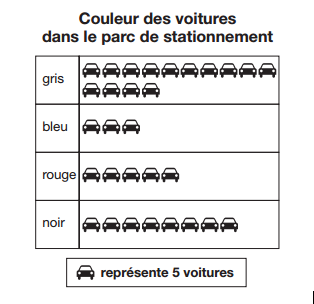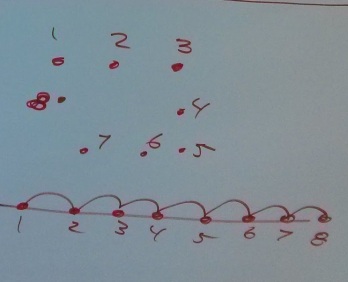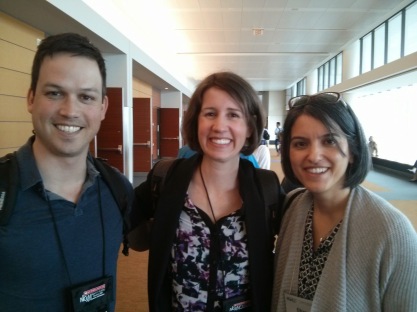Yes, that Elham did. Seriously.
Elham Kazemi gave me permission to take a time out during class…
… and by « me » I mean « everyone who teaches math ». So you too.
« Teacher Time Outs » she called them. The essence is this:
- You teach a lesson with other teachers present in the room (think collaborative inquiry).
- When you get stuck, as in you don’t know what question to ask or where to take the group next, you say « I’d like to take a Teacher Time Out » to the kids.
- Your students will be ok with it, they will look at your « You guys really are ok with this? » face and wait for you to have a chat with your colleagues.
- You chat with your colleagues.
- You come back and ask a stellar question.
- You wonder how you ever got by without this.
I first heard about this move when Elham presented at NCSM 2015. She also talked about them during ShadowCon – here is the talk and her call to action (she speaks about Teacher Time Outs starting at 3:55…). I didn’t think much about them in the week(s) that followed NCSM/NCTM, but then this happened:

A group of teachers and I presented this image to grade 2 students in a school that I work with. Even if you don’t read French, you probably noticed there are different categories (colours), there are a number of cars in each catagory, that there is a legend (1 picture reprensents 5 cars) and that there isn’t a question, among other things. The « no question » was part of the point. We wanted to try out « Notice and Wonder » with these students- the teachers had never tried it. We gave ourselves 10 minutes for our little try-out. After a few noticings by the students, we got to this point:
- Me: What do you notice?
- Student 1: I think the thing at the bottom means that for each car picture, it really means 5 cars.
- Me: Interesting. (Looking at another student)- What do you think of what she just said? (In my head- I just used a Talk Move!, the students are so going to understand the legend thing, no problem…)
- Student 2: Well, there are 14 grey, 3 blue, 5 red, 8 black (this is true for the pictures, but not how many are actually represented according to the legend).
- Me: (In my head- Uhh… but I just Talk Moved you and you didn’t… wait… what now?!!)
And then it hit me- Elham said I could. So I did. « Hey kids, I’m going to call a Teacher Time Out so I can talk with my teacher friends and I will be with you in just 1 minute. Is that OK? ». They said yes and I had a 1 minute conversation with the other teachers. « Should I push to get students thinking about what student 1 said, or should we gloss over and not worry about it for right now? » The conclusion was that if our goal was to see what Notice and Wonder is all about within our 10 minute timeframe in class , then we didn’t have to push for that understanding at that time. So I didn’t. I went back and started asking what the students were wondering. We were 5-6 teachers, professionnals, who decided together what to do in that instant. I felt pretty good about it.
Here’s the second story:
At another time, in another school with another group of teachers, we presented the dot image to a group of kindergarten students and asked them « How many? » and « How did you count them? ». We had given ourselves (the teachers) 10 minutes for a number talk. The teachers hadn’t really tried them and wanted to experiment. Love it. Prior to entering the classroom, we planned that the classroom teacher would facilitate and that a colleague would annotate student thinking on the whiteboard. « Hey, and if you get stuck, you can call a Teacher Time Out » I said and explained a little more. And they said « (laughter, laughter) Ok Pierre, nice idea… ». But once in the classroom, the math gods were on my side…
- Teacher: What do you see?
- Student: I see 2, 2, 2 and 2 (pairs of dots, horizontally, vertically and diagonally)
- Teacher: So how did you count them?
- Student: 1,2,3,4,5,6,7,8
- Teacher: …
The teacher looked up at me and at the other teachers and said « I think I actually need Time Out! ». So she did. Her kids didn’t freak out. They were awesome. So we, the teachers, got together to talk it out. « He saw pairs of dots but he’s counting by 1’s. Should I get him to count by 2’s? » The group decided that for now, we would leave it in order to try and keep the other students as engaged as possible; however, that the next move for the teacher with regard to the student in question would be to work with him in a small group setting in order to develop skip couting by 2. In other words, we utilized the student generated situation as a formative assessment in order to guide our next interventions. Brilliance. I am fairly certaint that, alone, the teacher or any one of us would have taken decided to take the same action.
Slowing it down. Not rushing it. The instant is no longer an instant, but an informed and thought out decision. This Teacher Time Out business really is powerful stuff. I personally experienced it and I watched somebody else experience it. Both times the kids had no problem with us having a chat with our friends and both times we came back with a question or a next move that was better than if we had done it alone.
So … Merci Elham!



Pierre! How about that! I love these examples. Thanks for sharing and will you also link this to the shadowcon website so we can get more people into the conversation. Each of these examples are nice ways to show teachers reaching out to each other and in this case, just let the ideas sit with the students. You might find teacher time outs also to be moments when you hear something that you want to follow up on, not necessarily a moment of stuckness, but a moment of, « hey…we didn’t think of this, let’s talk about this some more, » or « now, i’m really curious about asking you [the students] this question. »
J’aimeAimé par 1 personne
Thanks for the feedback! I will post to the ShadowCon website soon. As for the teacher time outs, yes, I will look to use them also in the way you described them. I love that when in a classroom and in a collaborative inquiry setting, teacher time outs give us permission to « interrupt » to ask that question- the agreement beforehand helps take away the feeling of not wanting to step on anyone’s toes. It’s not their lesson (as in the teacher’s), it becomes our lesson. All good stuff!
J’aimeJ’aime
In both of these examples, the teacher leading the lesson called the time out. Would it have felt intrusive/condescending or supportive/helpful if one of the other teachers had called a time out?
J’aimeJ’aime
Hi Joshua,
I think with the group of teachers I was with, it would have been taken as being supportive. With some another team, it could have been taken as being instrusive. I think it really depends on the relationship and the collaborative and safe environment that must be created in order to allow people to a take risks- especially when those risks are taken « publicly » in front of other teachers or even in front of their own students. I have been very fortunate to work with teachers that are open and willing.
J’aimeJ’aime
A question: did the students hear the discussions or did you move away to have them privately?
J’aimeJ’aime
Hi Sally,
In this instance, it was more of a private conversation; however, we didn’t try to make it like the students weren’t « allowed » to hear what we were saying. For having used the teacher time out in other instances since this blog post, we usually say something to the effect of « I need to take a time-out because I’m not exactly sure what to do next or what question to ask ». I think in this way, the students get the message that it’s not them, it’s us, the teachers, that need the extra time. If you have any more questions, feel free to ask away! Hope this helps…
J’aimeJ’aime